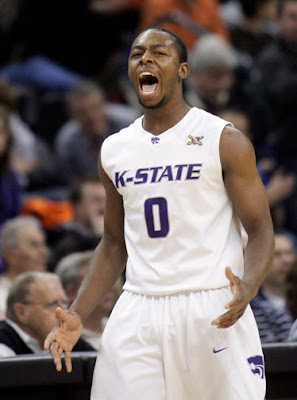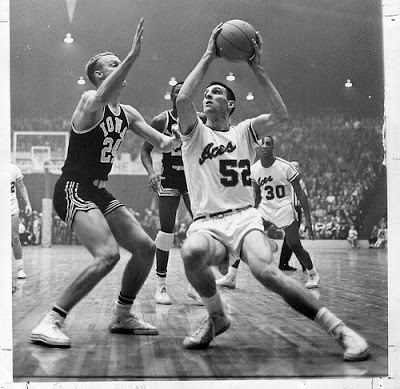 1. Syracuse (10-0)
1. Syracuse (10-0)
RBP preseason ranking: 3
KenPom rating: 5
KenPom offense: 8
KenPom defense: 9
Quality wins: Virginia Tech(n), Stanford(n), Florida
Losses: none
2. Kentucky (8-1)
RBP preseason ranking: 2
KenPom rating: 2
KenPom offense: 4
KenPom defense: 5
Quality wins: Kansas(n), North Carolina
Losses: @Indiana
3. Ohio State (8-1)
RBP preseason ranking: 5
KenPom rating: 3
KenPom offense: 5
KenPom defense: 2
Quality wins: Florida, Duke
Losses: @Kansas
4. North Carolina (8-2)
RBP preseason ranking: 1
KenPom rating: 4
KenPom offense: 6
KenPom defense: 10
Quality wins: UNLV(n), @Kentucky
Losses: Michigan State(n), Wisconsin
5. Louisville (9-0)
RBP preseason ranking: 7
KenPom rating: 10
KenPom offense: 60
KenPom defense: 4
Quality wins: Vanderbilt
Losses: none
6. Missouri (9-0)
RBP preseason ranking: 16
KenPom rating: 8
KenPom offense: 3
KenPom defense: 34
Quality wins: California(n), Villanova(n)
Losses: none
7. Marquette (9-0)
RBP preseason ranking: NR
KenPom rating: 7
KenPom offense: 9
KenPom defense: 18
Quality wins: @Wisconsin, Washington(n)
Losses: none
8. Connecticut (8-1)
RBP preseason ranking: 6
KenPom rating: 23
KenPom offense: 14
KenPom defense: 53
Quality wins: Florida State(n), Harvard
Losses: Central Florida(n)
9. Duke (9-1)
RBP preseason ranking: 4
KenPom rating: 9
KenPom offense: 7
KenPom defense: 29
Quality wins: Michigan State(n), Michigan(n), Kansas(n), Washington(n)
Losses: @Ohio State
10. Xavier (8-0)
RBP preseason ranking: 14
KenPom rating: 16
KenPom offense: 27
KenPom defense: 19
Quality wins: @Vanderbilt, Purdue, Cincinnati
Losses: none
11. Baylor (7-0)
RBP preseason ranking: 17
KenPom rating: 19
KenPom offense: 40
KenPom defense: 15
Quality wins: San Diego State, Northwestern
Losses:none
12. Florida (7-2)
RBP preseason ranking: 10
KenPom rating: 11
KenPom offense: 1
KenPom defense: 66
Quality wins: Arizona
Losses: @Ohio State, @Syracuse
13. Wisconsin (8-2)
RBP preseason ranking: 11
KenPom rating: 1
KenPom offense: 13
KenPom defense: 1
Quality wins: Brigham Young(n), UNLV
Losses: @North Carolina, Marquette
14. Indiana (9-0)
RBP preseason ranking: NR
KenPom rating: 13
KenPom offense: 12
KenPom defense: 39
Quality wins: North Carolina State, Kentucky
Losses: none
15. Michigan State (8-2)
RBP preseason ranking: NR
KenPom rating: 12
KenPom offense: 43
KenPom defense: 7
Quality wins: Florida State, @Gonzaga
Losses: North Carolina(n), Duke(n)
16. Kansas (7-2)
RBP preseason ranking: NR
KenPom rating: 6
KenPom offense: 17
KenPom defense: 11
Quality wins: Georgetown(n), Ohio State
Losses: Kentucky(n), Duke(n)
17. Georgetown (8-1)
RBP preseason ranking: NR
KenPom rating: 17
KenPom offense: 25
KenPom defense: 22
Quality wins: Memphis(n), @Alabama
Losses: Kansas(n)
18. Pittsburgh (9-1)
RBP preseason ranking: 8
KenPom rating: 28
KenPom offense: 2
KenPom defense: 141
Quality wins: Oklahoma State(n)
Losses: Long Beach State
19. Illinois (10-0)
RBP preseason ranking: NR
KenPom rating: 41
KenPom offense: 79
KenPom defense: 24
Quality wins: Gonzaga
Losses: none
20. Alabama (8-2)
RBP preseason ranking: NR
KenPom rating: 20
KenPom offense: 50
KenPom defense: 12
Quality wins: Wichita State(n), Purdue(n)
Losses: Georgetown, @Dayton
21. Vanderbilt (6-3)
RBP preseason ranking: 9
KenPom rating: 44
KenPom offense: 22
KenPom defense: 85
Quality wins: North Carolina State(n)
Losses: Cleveland State, Xavier, @Louisville
22. UNLV (9-2)
RBP preseason ranking: 25
KenPom rating: 25
KenPom offense: 16
KenPom defense: 49
Quality wins: North Carolina(n)
Losses: @Wichita State, @Wisconsin
23. Virginia (8-1)
RBP preseason ranking: NR
KenPom rating: 26
KenPom offense: 101
KenPom defense: 6
Quality wins: Michigan
Losses: TCU(n)
24. Mississippi State (9-1)
RBP preseason ranking: NR
KenPom rating: 50
KenPom offense: 52
KenPom defense: 61
Quality wins: Texas A&M(n), Arizona(n), West Virginia
Losses: Akron
25. Texas A&M (8-1)
RBP preseason ranking: 15
KenPom rating: 53
KenPom offense: 135
KenPom defense: 16
Quality wins: none
Losses: Mississippi State(n)
*On the cusp: Stanford, Murray State, Saint Louis
**All games played through Sunday considered. Ken Pomeroy numbers are current through Saturday.


































